By Leen Randell
Updated: Jul 04, 2024
10 Best Herbal Decoctions For Pimples
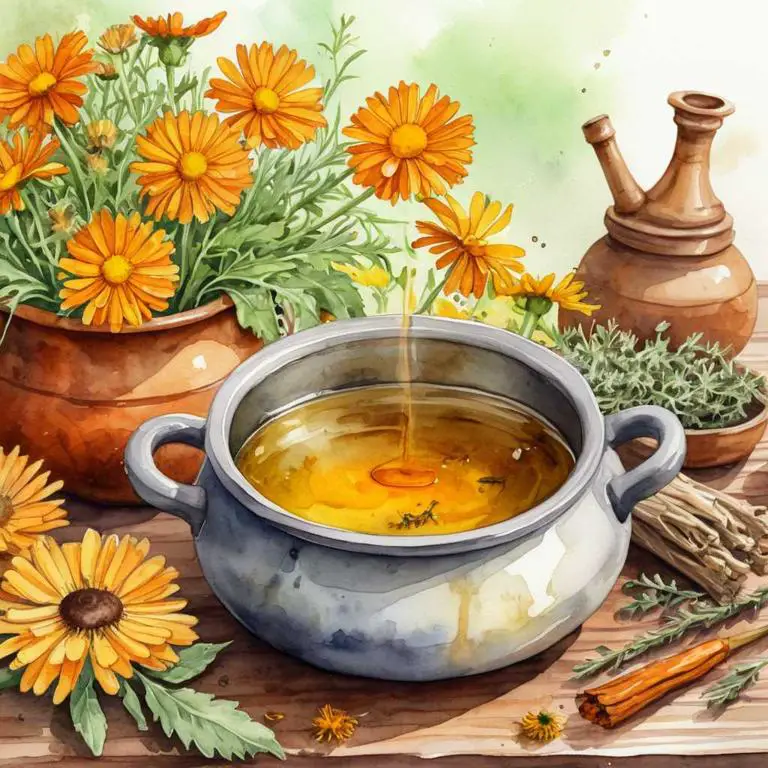
Herbal decoctions for pimples are concentrated liquid extracts made by steeping herbs in hot water, used to treat acne-prone skin.
They work by reducing inflammation, killing bacteria, and regulating hormonal imbalances that can contribute to pimple formation. Examples of effective herbal decoctions include neem, tea tree, and turmeric, which have antibacterial and anti-inflammatory properties that help soothe and clear the skin.
By using these decoctions, individuals with acne-prone skin can enjoy clearer, smoother complexions and increased confidence in their appearance.
The following article describes in detail the most important decoctions for pimples, including medicinal properties, parts of herbs to use, and recipes for preparations.
- 1. Salvia officinalis
- 2. Melissa officinalis
- 3. Calendula officinalis
- 4. Aloe vera
- 5. Taraxacum officinale
- 6. Geranium maculatum
- 7. Echinacea angustifolia
- 8. Hamamelis virginiana
- 9. Vaccinium macrocarpon
- 10. Althaea officinalis
- What is the best combination of herbal decoctions to use for pimples?
- What ailments similar to pimples are treated with herbal decoctions?
1. Salvia officinalis
Sage decoctions helps with pimples because its antiseptic and anti-inflammatory properties soothe and calm the skin, reducing redness and swelling.
The antibacterial compounds in sage also help to eliminate acne-causing bacteria, preventing clogged pores and breakouts. Additionally, sage's antioxidant properties help to reduce oxidative stress, which can contribute to inflammation and acne.
As a result, incorporating sage decoctions into your skincare routine can lead to clearer, healthier-looking skin and a reduced appearance of pimples.
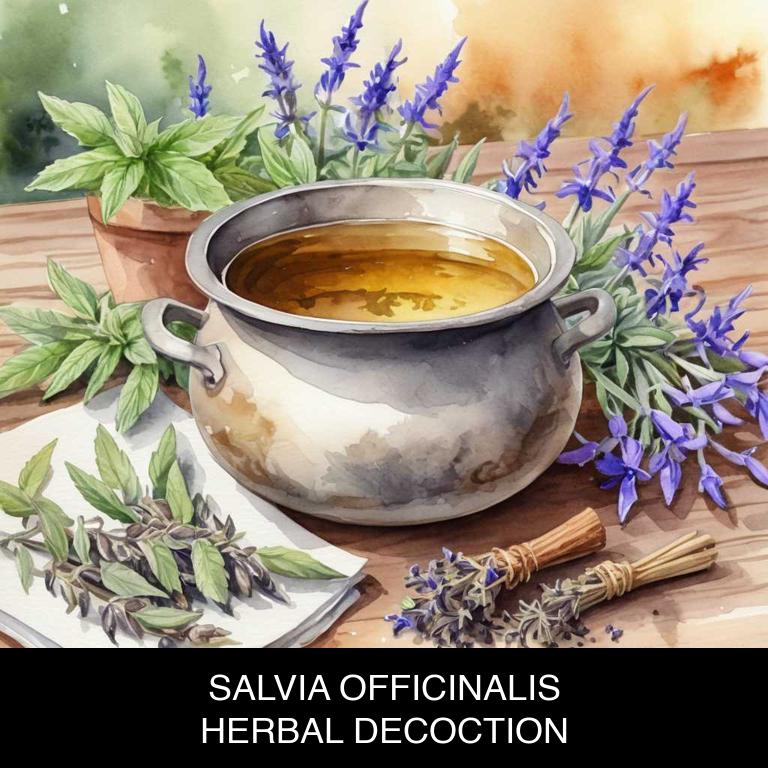
Medicinal Constituents
The list below shows the primary medicinal constituents in Salvia officinalis decoctions that help with pimples.
- Salvianolic acid a: This water-soluble phenolic acid helps with pimples by reducing inflammation and oxidative stress, which can contribute to acne development.
- Carnosic acid: This phenolic diterpene has antioxidant and anti-inflammatory properties, which can help to soothe and calm the skin, reducing the severity of pimples.
- Rosmarinic acid: This phenolic diterpene has antimicrobial properties, which can help to prevent bacterial overgrowth on the skin, a common cause of pimples.
Parts Used
The list below shows the primary parts of sage used to make decoctions for pimples.
- Leaves: Used for their antimicrobial and anti-inflammatory properties to help reduce inflammation and prevent infections associated with pimples.
- Flowers: Utilized for their antiseptic and antifungal properties to combat acne-causing bacteria and reduce the severity of pimples.
- Stems: Employed for their anti-inflammatory and antioxidant properties to soothe and calm the skin, reducing redness and inflammation associated with pimples.
Quick Recipe
The following recipe gives a procedure to make a basic sage for pimples.
- Harvest 2-3 tablespoons of dried salvia officinalis leaves to use for decoction.
- Combine the dried leaves with 2 cups of water in a saucepan over medium heat.
- Bring the mixture to a boil and then reduce the heat to low for 10-15 minutes.
- Strain the decoction through a cheesecloth or fine-mesh sieve into a clean container.
- Allow the decoction to cool before serving.
2. Melissa officinalis
Lemon balm decoctions helps with pimples because it possesses natural antibacterial and anti-inflammatory properties that combat acne-causing bacteria and reduce redness.
The antiseptic compounds in lemon balm also help to unclog pores, allowing for a clearer complexion. Additionally, the soothing effects of lemon balm can calm irritated skin, reducing inflammation and promoting a smoother appearance.
By incorporating lemon balm decoctions into one's skincare routine, individuals may experience a significant reduction in pimple size and severity, leading to healthier-looking skin.
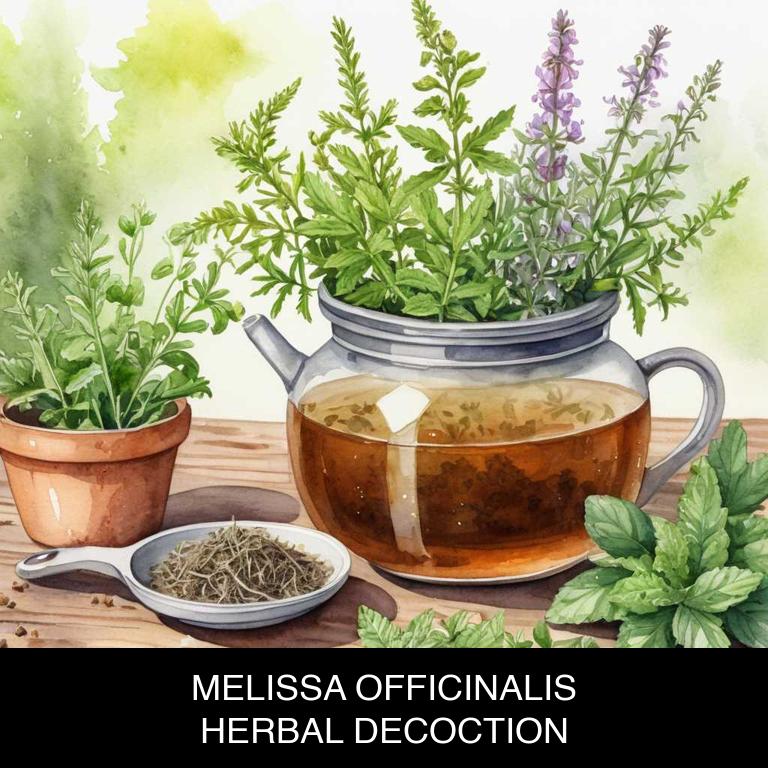
Medicinal Constituents
The list below shows the primary medicinal constituents in Melissa officinalis decoctions that help with pimples.
- Rosmarinic acid: This phenolic compound has antioxidant and anti-inflammatory properties, which can help reduce redness and inflammation associated with pimples.
- Luteolin: As a flavonoid, luteolin has been shown to possess anti-inflammatory and antioxidant properties, which can help soothe and calm the skin, reducing the severity of pimples.
- Oleanolic acid: This triterpenoid has been found to have anti-inflammatory and antibacterial properties, which can help combat the bacterial overgrowth that can contribute to the development of pimples.
Parts Used
The list below shows the primary parts of lemon balm used to make decoctions for pimples.
- Leaves: They are used because of their antimicrobial and anti-inflammatory properties, which help to soothe and calm acne-prone skin.
- Flowers: They are used because of their antiseptic and antifungal properties, which aid in reducing inflammation and preventing infection in pimples.
- Stems: They are used because of their astringent properties, which help to tighten pores and reduce oiliness, making them an effective remedy for acne.
Quick Recipe
The following recipe gives a procedure to make a basic lemon balm for pimples.
- Gather 2-3 teaspoons of dried melissa officinalis flowers for decoction.
- Combine the dried herb with 8 ounces of boiling water in a saucepan.
- Steep the mixture for 5-10 minutes to allow flavors to infuse.
- Strain the decoction through a cheesecloth or a fine-mesh sieve into a cup.
- Drink the decoction immediately while warm to experience its benefits.
3. Calendula officinalis
Pot marigold decoctions helps with pimples because of its potent antibacterial, anti-inflammatory, and antiseptic properties.
The flavonoids and terpenoids present in calendula, the herb from which pot marigold is derived, help to reduce inflammation and combat bacterial overgrowth that can lead to acne. Additionally, the decoction's antioxidant properties help to soothe and calm irritated skin, reducing redness and promoting faster healing of pimples.
By using pot marigold decoctions topically, individuals can effectively address pimple-prone skin concerns and achieve a clearer, healthier complexion.

Medicinal Constituents
The list below shows the primary medicinal constituents in Calendula officinalis decoctions that help with pimples.
- Triterpenoids: These compounds help reduce inflammation and promote wound healing, which can aid in the resolution of pimple lesions and reduce the risk of scarring.
- Flavonoids: As antioxidants, flavonoids help protect the skin from oxidative stress and damage caused by free radicals, which can contribute to the development and severity of pimples.
- N-alkanes: These compounds exhibit antimicrobial properties, which can help combat bacterial infections, such as acne caused by Propionibacterium acnes (P. acnes), that can lead to the formation of pimples.
Parts Used
The list below shows the primary parts of pot marigold used to make decoctions for pimples.
- Flowers: They are the most used part due to their high content of anti-inflammatory and antiseptic compounds, which help to reduce redness and prevent infection.
- Leaves: They contain similar properties to the flowers, making them effective in treating pimples and promoting healing.
Quick Recipe
The following recipe gives a procedure to make a basic pot marigold for pimples.
- Harvest a sufficient amount of dried calendula officinalis flowers approximately 1 tablespoon for a decoction.
- Combine the dried flowers with 1 cup of boiling water in a heat-resistant glass bowl.
- Reduce heat to a simmer and let the mixture steep for 5 to 7 minutes.
- Strain the mixture through a fine-mesh sieve or cheesecloth into a clean container.
- Discard the solids and store the decoction in the refrigerator for up to 3 days.
4. Aloe vera
Aloe decoctions helps with pimples because it has anti-inflammatory properties that soothe and calm irritated skin, reducing redness and swelling.
The antimicrobial compounds in aloe vera also help to combat bacteria that can cause acne, preventing further breakouts. Additionally, the natural antibacterial agents in aloe vera can reduce inflammation and promote healing, helping to clear up pimples quickly.
Overall, aloe decoctions offer a gentle yet effective way to address acne-prone skin without harsh chemicals or drying agents.

Medicinal Constituents
The list below shows the primary medicinal constituents in Aloe vera decoctions that help with pimples.
- Aloe-emodin: Aloe-emodin is a anthraquinone compound that has anti-inflammatory and antibacterial properties, which help to reduce redness and prevent infection of pimples.
- Sitosterol: Sitosterol is a plant sterol that has anti-inflammatory and antioxidant properties, which help to soothe and calm the skin, reducing inflammation and promoting healing of pimples.
- Salicylic acid: Salicylic acid is a phenolic compound that has keratolytic properties, which help to break down the dead skin cells and excess oil that clog pores and cause pimples.
Parts Used
The list below shows the primary parts of aloe used to make decoctions for pimples.
- Leaves: They are used due to their high concentration of aloe vera gel, which has anti-inflammatory and soothing properties that help to reduce pimple inflammation and promote healing.
- Seeds: They are used due to their oil content, which has been shown to have antibacterial and anti-inflammatory properties that can help to combat pimple-causing bacteria and reduce inflammation.
- Buds: They are used due to their high concentration of bioactive compounds, including vitamins and minerals, which can help to reduce pimple inflammation and promote skin health.
Quick Recipe
The following recipe gives a procedure to make a basic aloe for pimples.
- Gather 5-7 fresh aloe vera leaves and wash them thoroughly under cold running water for 3 minutes.
- Chop the aloe vera leaves into small pieces and add them to a large pot filled with 4 cups of water.
- Heat the water over medium heat for 20-30 minutes or until the liquid is reduced by half and has a thick consistency.
- Strain the decoction through a cheesecloth or fine-mesh sieve into a clean container to remove any solids.
- Allow the decoction to cool to room temperature before transferring it to an airtight container for storage.
5. Taraxacum officinale
Dandelion decoctions helps with pimples because its bitter compounds, such as taraxasterol and taraxadiol, have natural anti-inflammatory properties that reduce redness and swelling associated with acne.
The decoction's antiseptic qualities also help to combat bacterial infections that can cause breakouts, while its diuretic properties promote healthy digestion and liver function, which is essential for removing toxins from the body that can contribute to acne formation.
By incorporating dandelion decoctions into your skincare routine, you can effectively address pimple-causing issues from the inside out.

Medicinal Constituents
The list below shows the primary medicinal constituents in Taraxacum officinale decoctions that help with pimples.
- Inulin: Inulin is a prebiotic that helps regulate gut bacteria, which can contribute to inflammation and acne. By promoting a balanced gut microbiome, inulin may help reduce inflammation and prevent pimples.
- Phenolic acids: Phenolic acids have antioxidant and anti-inflammatory properties, which can help reduce inflammation and oxidative stress that contribute to pimple formation.
- Taraxasterol: Taraxasterol has been shown to have anti-inflammatory and antimicrobial properties, which can help reduce inflammation and prevent the growth of bacteria that can cause acne.
Parts Used
The list below shows the primary parts of dandelion used to make decoctions for pimples.
- Roots: They contain inulin, a prebiotic that can help reduce inflammation and promote wound healing, making them effective in treating pimples.
- Leaves: They contain taraxasterol, a triterpenoid that has anti-inflammatory and antimicrobial properties, which can help reduce the severity of pimples.
- Flowers: They contain flavonoids and carotenoids, which have antioxidant and anti-inflammatory properties that can help soothe and calm the skin, reducing the appearance of pimples.
Quick Recipe
The following recipe gives a procedure to make a basic dandelion for pimples.
- Harvest taraxacum officinale leaves and roots in the morning after the dew has dried for best results.
- Clean the taraxacum officinale leaves and roots thoroughly with cold water and dry them immediately.
- Combine 2-3 grams of dried taraxacum officinale leaves and roots with 100 milliliters of cold water in a saucepan.
- Bring the mixture to a boil over high heat then reduce the heat to a simmer for 5-7 minutes.
- Strain the decoction through a cheesecloth into a clean container and discard the solids.
6. Geranium maculatum
Wild geranium decoctions helps with pimples because they possess antibacterial, anti-inflammatory, and antiseptic properties that effectively combat acne-causing bacteria and reduce redness and swelling.
The decoction's ability to balance the skin's natural pH levels also prevents excessive oil production, clogging pores, and promoting a healthy skin environment.
Additionally, its antioxidant properties help to soothe and calm the skin, reducing inflammation and promoting a clearer complexion.
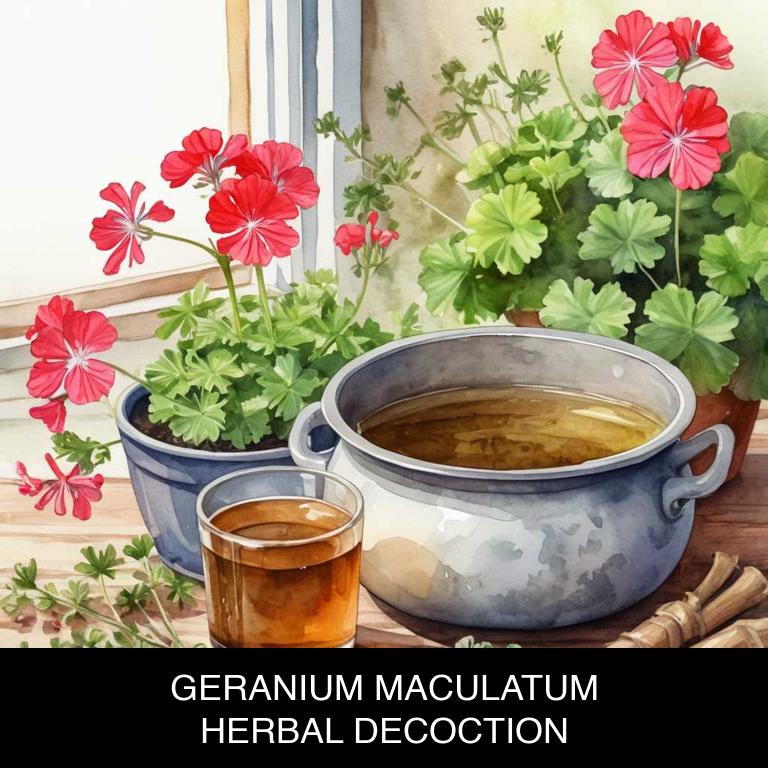
Medicinal Constituents
The list below shows the primary medicinal constituents in Geranium maculatum decoctions that help with pimples.
- Flavonoids: These plant compounds help reduce inflammation and oxidative stress, which can contribute to the development and severity of pimples.
- Phenolic acids: Phenolic acids in Geranium maculatum decoctions have antimicrobial properties, which can help prevent the growth of bacteria that cause acne and pimples.
- Tannins: Tannins in Geranium maculatum decoctions have astringent and anti-inflammatory properties, which can help reduce redness and swelling associated with pimples.
Parts Used
The list below shows the primary parts of wild geranium used to make decoctions for pimples.
- Roots: The roots of Geranium maculatum are used due to their antiseptic and anti-inflammatory properties, which can help reduce redness and inflammation associated with pimples.
- Leaves: The leaves of Geranium maculatum are used for their astringent properties, which can help tighten pores and reduce the appearance of acne.
- Flowers: The flowers of Geranium maculatum are used for their anti-inflammatory and antiseptic properties, which can help soothe and calm irritated skin, reducing the severity of pimples.
Quick Recipe
The following recipe gives a procedure to make a basic wild geranium for pimples.
- Harvest the flowering stems of the geranium maculatum plant at the end of the blooming season.
- Chop 1 ounce of the harvested plant material into small pieces to increase its surface area.
- Combine the chopped plant material with 2 cups of water in a saucepan and bring to a boil.
- Reduce the heat and simmer the mixture for 10 to 20 minutes or until the liquid has reduced slightly.
- Strain the decoction through a cheesecloth or a fine-mesh sieve into a clean container to remove the solids.
7. Echinacea angustifolia
Kansas coneflower decoctions helps with pimples because of its anti-inflammatory and antimicrobial properties.
The decoction's active compounds, such as triterpenoids and phenolic acids, can effectively reduce redness and swelling associated with acne. Additionally, the decoction's antibacterial activity helps combat P. acnes, a common bacteria that causes breakouts.
By reducing inflammation and combating bacterial growth, Kansas coneflower decoctions provide a natural and effective way to help clear up pimples and promote healthy, clear skin.

Medicinal Constituents
The list below shows the primary medicinal constituents in Echinacea angustifolia decoctions that help with pimples.
- Iridoid glycosides: These compounds have anti-inflammatory properties that may help reduce redness and swelling associated with pimples, promoting a more even skin tone.
- Alkaloids: These compounds exhibit antimicrobial properties, which can help combat bacterial overgrowth on the skin, a common cause of pimples, and reduce inflammation.
- Cichoric acid: Cichoric acid has potent antioxidant properties, which can help neutralize free radicals and reduce oxidative stress on the skin, potentially leading to less acne and inflammation.
Parts Used
The list below shows the primary parts of kansas coneflower used to make decoctions for pimples.
- Roots: Rich in compounds with anti-inflammatory and antimicrobial properties, which can help soothe and clear up pimples.
- Leaves: Contain flavonoids and phenolic acids with antioxidant and anti-inflammatory properties, which can reduce inflammation and fight infection associated with pimples.
- Stems: Similar to roots, stems also contain compounds with anti-inflammatory and antimicrobial properties, making them effective in treating pimples.
Quick Recipe
The following recipe gives a procedure to make a basic kansas coneflower for pimples.
- Harvest the roots of echinacea angustifolia plants in late fall or early spring when they are dormant.
- Clean and dry the harvested roots to prevent contamination and preserve their medicinal properties for up to a year.
- Grate or chop 5-10 grams of the dried roots to increase their surface area for decoction.
- Combine the grated roots with 250-500 milliliters of water in a saucepan and bring to a boil.
- Simmer the decoction for 10-15 minutes to extract the active compounds from the roots.
8. Hamamelis virginiana
American witch hazel decoctions helps with pimples because of its antibacterial, anti-inflammatory, and astringent properties.
The decoction's high concentration of tannins and flavonoids helps to reduce inflammation and redness associated with acne, while its antimicrobial properties combat the bacteria that cause breakouts. Additionally, witch hazel's natural astringent properties help to dry out pimples and reduce their appearance, leaving skin looking clearer and more balanced.
This natural remedy can provide effective relief from acne without harsh chemicals or synthetic ingredients.
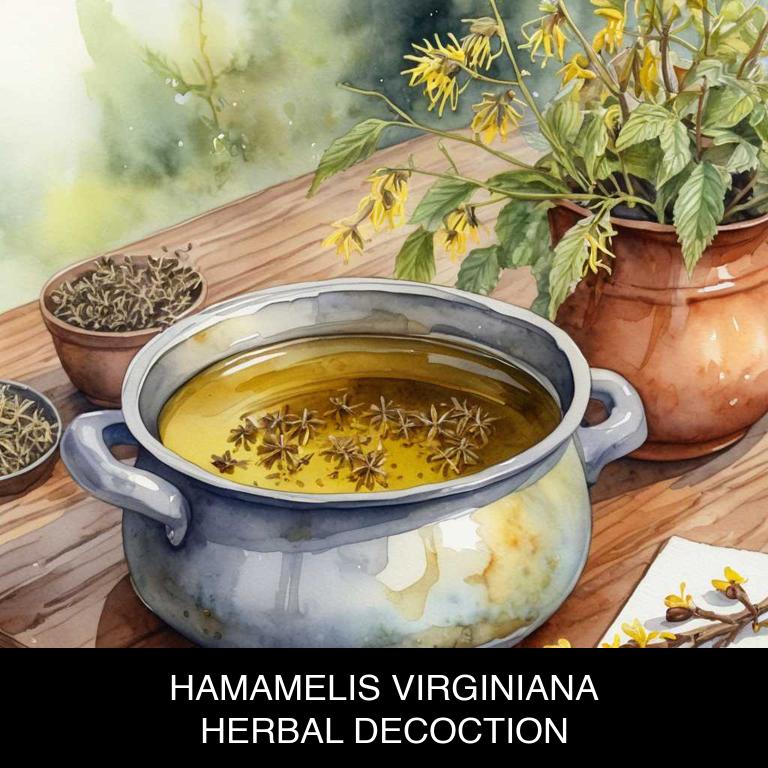
Medicinal Constituents
The list below shows the primary medicinal constituents in Hamamelis virginiana decoctions that help with pimples.
- Tannins: They have astringent properties that help reduce inflammation and dry out pimples, making them less noticeable.
- Hamamelitannin: This specific tannin has potent antimicrobial and anti-inflammatory effects, which can help combat the underlying causes of pimples, such as bacterial infections and inflammation.
- Quercetin: A flavonoid that exhibits anti-inflammatory and antioxidant properties, quercetin can help soothe and calm the skin, reducing redness and inflammation associated with pimples.
Parts Used
The list below shows the primary parts of american witch hazel used to make decoctions for pimples.
- Buds: They are used due to their anti-inflammatory and astringent properties, which help to reduce acne and soothe skin irritations.
- Leaves: They are used because of their antimicrobial and antioxidant properties, which help to prevent bacterial growth and reduce inflammation in pimples.
- Roots: They are used due to their anti-inflammatory and antiseptic properties, which help to reduce redness and prevent infection in acne-prone skin.
Quick Recipe
The following recipe gives a procedure to make a basic american witch hazel for pimples.
- Gather 1 cup of fresh hamamelis virginiana twigs and leaves or 2 tablespoons of dried material.
- Combine the gathered plant material with 4 cups of water in a saucepan.
- Bring the mixture to a boil over high heat then reduce the heat to medium-low for 10 minutes.
- Strain the decoction through a cheesecloth or a fine-mesh sieve into a clean container.
- Store the finished decoction in the refrigerator for up to 3 days and take 1/4 cup as needed.
9. Vaccinium macrocarpon
Highbush cranberry decoctions helps with pimples because of its unique combination of antioxidants, anti-inflammatory compounds, and astringent properties.
The decoction's potent antioxidant capacity helps neutralize free radicals that can cause skin damage and inflammation, while its anti-inflammatory effects reduce redness and swelling associated with acne. Additionally, the astringent properties help dry out excess oil and shrink pores, reducing the appearance of pimples and preventing new ones from forming.
As a result, highbush cranberry decoctions offer a natural and effective solution for soothing and clearing up acne-prone skin.
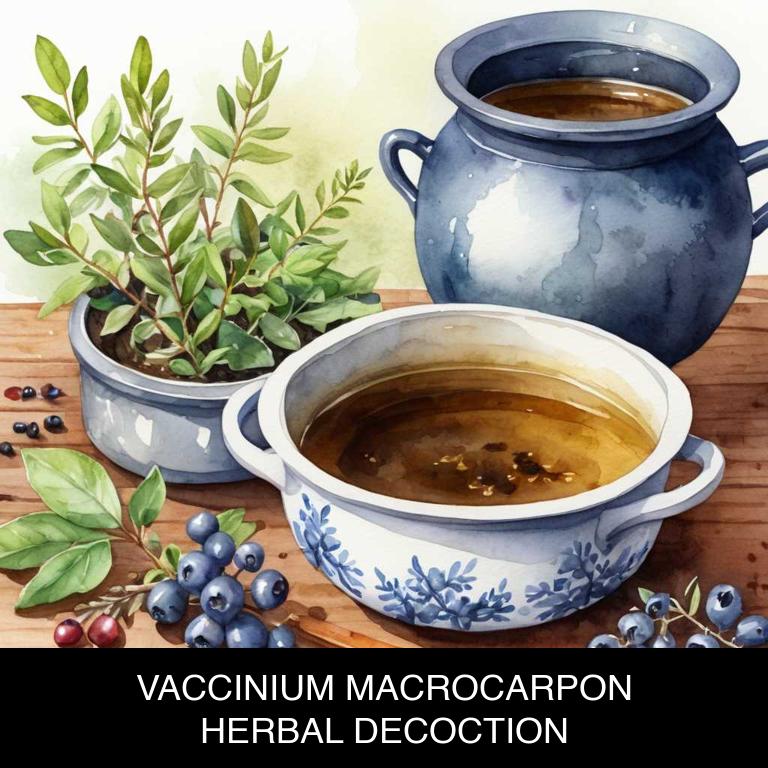
Medicinal Constituents
The list below shows the primary medicinal constituents in Vaccinium macrocarpon decoctions that help with pimples.
- Anthocyanins: These powerful antioxidants help reduce inflammation and oxidative stress, which can contribute to pimple formation and severity.
- Flavonoids: These anti-inflammatory compounds inhibit the production of pro-inflammatory enzymes and cytokines, which can exacerbate acne and pimple formation.
- Catechins: This catechin has antibacterial properties, helping to combat acne-causing bacteria such as Propionibacterium acnes (P. acnes), which can contribute to pimple development.
Parts Used
The list below shows the primary parts of highbush cranberry used to make decoctions for pimples.
- Fruits: Used because they are high in antioxidants and anti-inflammatory properties, which help to reduce inflammation and combat acne-causing bacteria.
- Leaves: Used because they contain tannins and other compounds that have astringent and antibacterial properties, which help to reduce acne and prevent future breakouts.
- Barks: Used because they contain flavonoids and other compounds that have anti-inflammatory and antioxidant properties, which help to soothe and calm the skin, reducing redness and inflammation associated with pimples.
Quick Recipe
The following recipe gives a procedure to make a basic highbush cranberry for pimples.
- Gather 20-30 grams of dried vaccinium macrocarpon berries and clean them thoroughly with a fine mesh strainer.
- Combine the cleaned vaccinium macrocarpon berries with 500 milliliters of cold water in a stainless steel pot.
- Boil the mixture for 10-15 minutes at a moderate heat level to release the bioactive compounds.
- Reduce the heat to a low level and simmer the decoction for an additional 20-30 minutes.
- Strain the decoction through a cheesecloth or a fine mesh strainer into a clean glass container.
10. Althaea officinalis
Marshmallow decoctions helps with pimples because its mucilaginous properties soothe and calm the skin, reducing inflammation and redness associated with acne.
The antioxidant-rich compounds in marshmallow root also help to neutralize free radicals that can contribute to pimple formation.
Additionally, marshmallow's anti-inflammatory effects may help to reduce sebum production, unclog pores, and prevent bacteria from thriving, ultimately leading to a clearer and more balanced complexion.

Medicinal Constituents
The list below shows the primary medicinal constituents in Althaea officinalis decoctions that help with pimples.
- Mucilages: Mucilages help soothe and calm the skin, reducing inflammation and redness associated with pimples by forming a protective barrier that shields the skin from further irritation.
- Saponins: Saponins possess anti-inflammatory and antibacterial properties, which help combat acne-causing bacteria and reduce inflammation, ultimately leading to a decrease in pimple severity and frequency.
- Triterpenes: Triterpenes exhibit anti-inflammatory and antioxidant properties, which help reduce the production of pro-inflammatory cytokines and free radicals that contribute to pimple formation and exacerbate inflammation.
Parts Used
The list below shows the primary parts of marshmallow used to make decoctions for pimples.
- Roots: The roots are used due to their high mucilage content, which helps to soothe and calm the skin.
- Leaves: The leaves are used due to their antimicrobial properties, which aid in reducing inflammation and preventing infections associated with pimples.
- Barks: The barks are used due to their anti-inflammatory properties, which help to reduce redness and swelling caused by pimples.
Quick Recipe
The following recipe gives a procedure to make a basic marshmallow for pimples.
- Harvest fresh or dried roots of althaea officinalis in the summer months or as needed.
- Rinse the harvested roots with cool water to remove any dirt or debris.
- Chop the cleaned roots into small pieces and use a ratio of 1 part roots to 2 parts water.
- Bring the root and water mixture to a boil in a pot over medium heat for 10 to 15 minutes.
- Strain the decoction through a cheesecloth or fine-mesh sieve into a clean container to remove the solids.
What is the best combination of herbal decoctions to use for pimples?
The best combination of herbal decoctions that help with pimples is a blend of neem, tea tree, and aloe vera.
Neem decoction helps to reduce inflammation and kills bacteria that cause pimples, while tea tree decoction has antimicrobial properties that combat acne-causing germs. Aloe vera, rich in soothing properties, calms and hydrates the skin, reducing redness and promoting healing.
This trio of herbal decoctions can be mixed and taken as a tea, or applied topically to the affected area to help clear up pimples naturally.
What ailments similar to pimples are treated with herbal decoctions?
Ailments similar to pimples/decoctions.html">pimples/decoctions.html">pimples that are treated with herbal decoctions are acne, eczema, and rosacea.
Herbs like neem, turmeric, and ginger are commonly used to prepare decoctions that help reduce inflammation, kill bacteria, and promote healing of the skin.
These decoctions can also be used to treat other skin issues such as boils, abscesses, and ulcers, providing a natural alternative to conventional treatments.